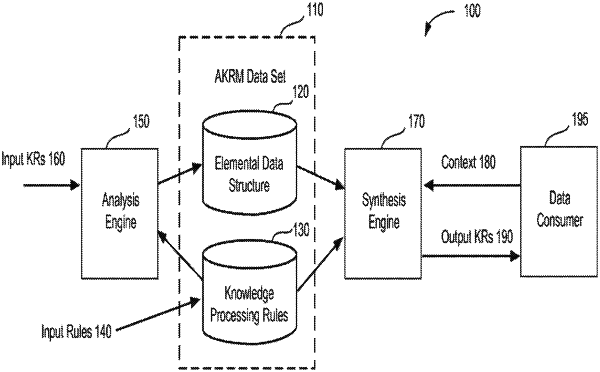| CPC G06F 16/212 (2019.01) [G06F 16/211 (2019.01); G06F 16/248 (2019.01); G06N 5/02 (2013.01); G06N 5/022 (2013.01); Y04S 10/50 (2013.01)] | 19 Claims |

|
1. A system for supporting machine-based inductive reasoning to predict new complex knowledge representations encoded as computer-readable data and stored on one or more tangible, non-transitory computer-readable storage media, the system comprising:
an atomic knowledge representation model (“AKRM”) stored as machine-readable data and/or programming instructions on the one or more tangible, non-transitory computer-readable storage media, the AKRM comprising: (i) one or more knowledge processing rules, and (ii) an elemental data structure comprising a first knowledge representation encoded as a first computer-readable data structure and comprising a first set of elemental components including a plurality of elemental concepts and at least one elemental concept relationship between the elemental concepts;
one or more processors configured to execute a synthesis engine, an inference engine, and a statistical engine, wherein the synthesis engine, the inference engine, and the statistical engine operate together to perform synthesis of a second knowledge representation from the elemental data structure, the second knowledge representation encoded as a second computer-readable data structure, wherein the synthesis includes:
the synthesis engine applying the one or more knowledge processing rules to the elemental data structure to synthesize one or more additional concepts or concept relationships not explicitly encoded in the first knowledge representation, the one or more additional concepts or concept relationships being encoded in the second knowledge representation;
the inference engine applying one or more inference rules to the elemental data structure or to reference data stored in the one or more tangible, non-transitory computer-readable storage media to infer a relationship between a first elemental concept in the first knowledge representation and a second elemental concept in the first knowledge representation or between the first elemental concept in the first knowledge representation and a concept in the reference data; and
the statistical engine estimates one or more probabilities associated with the elemental concepts or the at least one elemental concept relationship in the elemental data structure;
and wherein the synthesis engine synthesizes the second knowledge representation based on an output of at least one of the inference engine and the statistical engine.
|